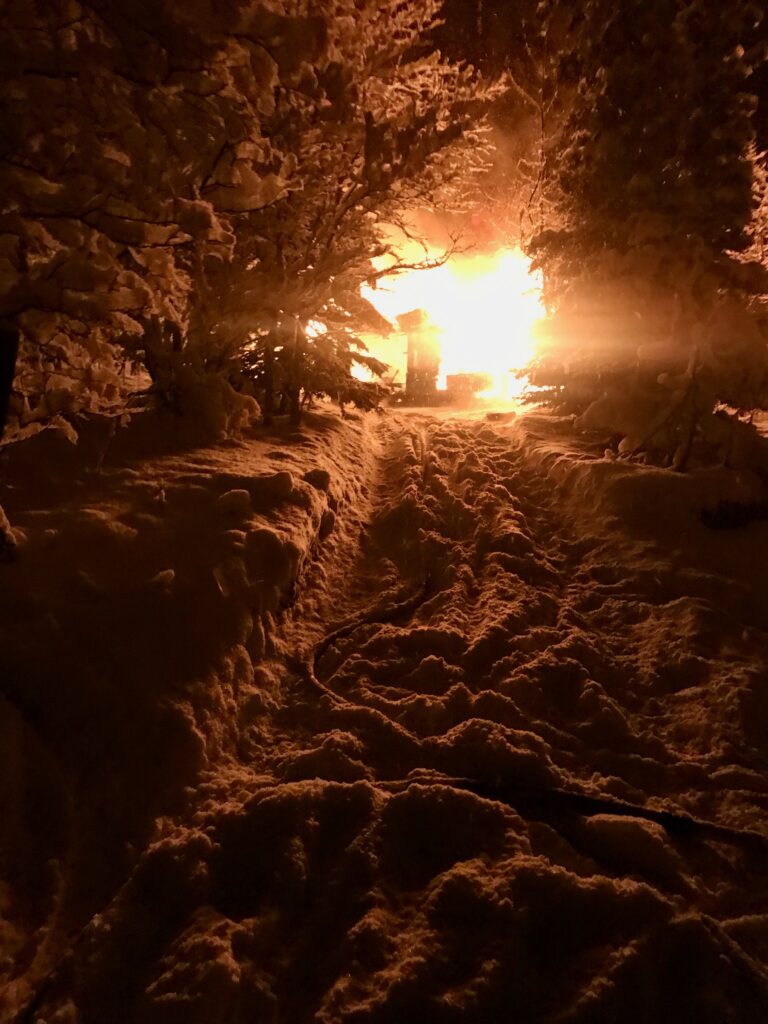***Fair warning. Our neighbor’s house burned down recently, so this could be sensitive material for someone to read.***
Crackle, crackle, crackle, crackle.
“What’s that noise?” Justin says.
We were watching a movie on our iPad in bed, but that semi-distant crackling noise was too much to ignore for my alarmist husband.
“Do you think our well house is on fire?” We were testing a new heater in our well house, so he was jumping at every noise.
When Justin opened our front door, the orange sky was real, very, very real.
“There’s a fire up the hill! Call Sarah!” Justin started mobilizing quickly. He always keeps his clothes at the bottom of our bed (not neatly stacked much to my chagrin, but available nonetheless, because as he argues, “what if there is an emergency?)
Sarah & Ryno live up the hill behind us. There are probably 6 cabins up there, with a few different owners.
“Sarah! What’s going on up there? Are you guys okay? We see fire from down here!” I’m holding the phone while simultaneously layering up to brave the -10 temps. Sarah has no idea the cabin across from her is on fire. I run outside to catch up to Justin, who is getting the story from the neighbors (and accidentally butt-dial my sister, who awakes on the East Coast to hearing muffled voices and panic on the other side of the phone. Who butt dials anymore??? Apparently I do. At the wrong time).
It’s a rental property that’s on fire started in the coal/wood stove. The renter and his visiting son are in their truck, waiting for emergency vehicles to arrive. The older gentleman didn’t even have time to put on shoes before vacating the property. They think the stove was running too hot and the fire started in the pipe before they noticed shooting flames coming from the roof.

One fire truck from our volunteer fire department arrives and mobilizes. They decide because it is snowing and the hill is a bit tight and steep, they should just pull the hoses up to house. We all help lay out the hoses and haul them up the hill. I realize I put on the wrong clothing, with my fleece-lined knit gloves instead of heartier waterproof gloves. I feel the hot breath from the fire, yet I’m shivering.
One of the fire department volunteers asks Justin to go down the hill to retrieve an oxygen tank and supplies. He lugs the equipment back up the hill, only to have the volunteer ask him if he always wanted to be a firefighter.
“Yeah! I’ll do whatever!”
He instructs Justin to get on one knee and aim the hose at the fire, while he gets suited up with the oxygen. Justin sprays for a few minutes before turning the duties back over and coming down the hill. By this time, other trucks full of water (no fire hydrants here) and volunteers have arrived and there are plenty of helping hands. I think there ended up being 9 emergency vehicles on our tiny street. We sort of just linger and stand back to watch for the next few hours.

The next morning, the wreckage is still smoldering, and it’s a total loss. The renters take what they can salvage of their own belongings and the owner will eventually weed through the pile of rubble as well. It is sad, very sad.



But this post is also a small PSA about safety.
When we first looked at our cabin to buy, the first thing we noticed was no wood stove. We’re both disappointed, as we love cozy look and have been warmed by them in places we lived on and off over the years.
But they take a lot of work. In Alaska, if you don’t keep the fire lit around a clock through a night of below 0 temps, there’s a real danger of freezing to the death. That equates to a lot of felling trees, chopping logs, hauling and stacking cords of wood. It is simply part of life in the far north. I shudder when thinking about our other neighbor, who literally never stocks enough wood to keep his tiny cabin above 50 and is just used to being cold.
Beyond working hard to stay warm, there’s the maintenance of stoves. The tinkering with flume, airflow and smoke. Justin & I experienced a chimney fire in 2012, and learned the hard way how imperative regular chimney cleaning is. When we were caretaking the property in New Mexico, we were probably over the top with cleaning and maintenance and preparedness, but we didn’t want to take any chances. I think it’s too easy to become complacent with wood stoves.
I’m not saying our Toyo Oil Heater here in our Alaska cabin is not without risk, or maintenance, or precious resources. But I appreciate its efficiency to warm up our 300 square feet, keep it consistently between 58-70 degrees without much effort on our part. I recognize that the cost of heating oil is prohibitive for some. We’ve filled our 300-gallon tank twice, and have seen the cost vary between $2-3.50 per gallon. It adds about $10-15 to our electric bill.


My frailty comes with temperature and safety. I’ll take the Toyo.







I’m so sorry to hear about this fire but glad all people are okay. Yes, wood stoves can lead to chimney fires. Toyos are less hassle and safer as long as you service them as needed. Stay warm and safe.
I hope Justin joins the volunteer fire department. Sounds like he is already a natural fit!